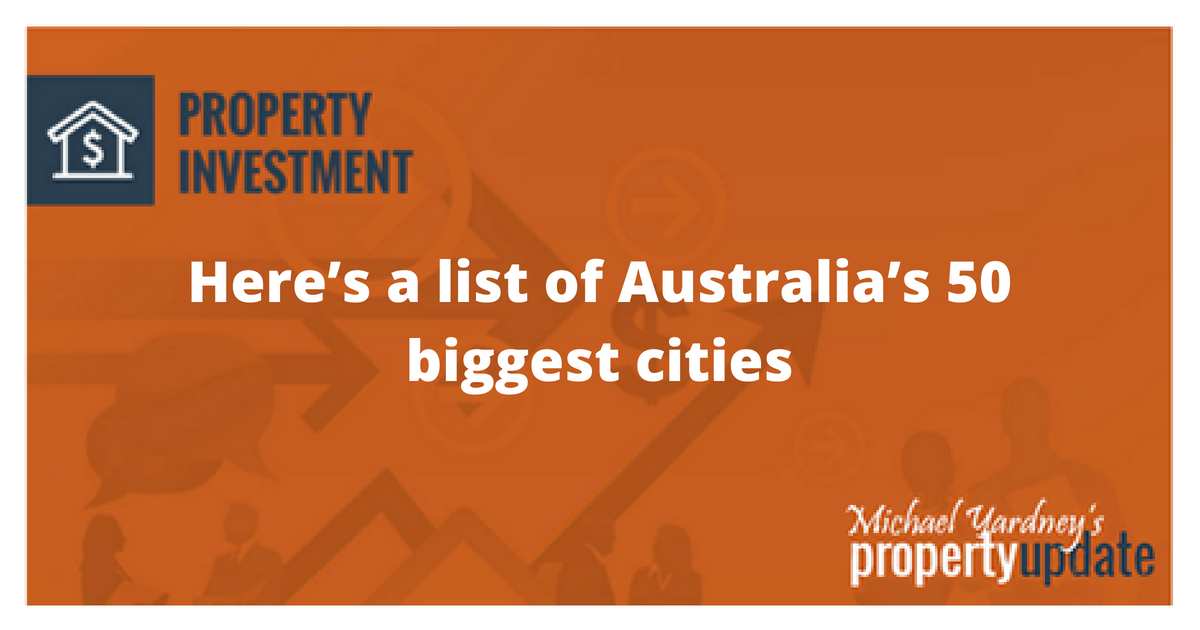Here’s a list of Australia’s 50 largest cities.
Of course Sydney remains Australia’s largest city — but maybe not for long.
There are now just 200,000 people separating Melbourne from Sydney — 4.9 million compared to 5.1 million — and if current trends continue the Victorian capital is poised to become the largest city in Australia in eight years, according to new Australian Bureau of Statistics data.
 Melbourne grew by 2.7 per cent in one year, 2016-17, adding more than 125,000 people.
Melbourne grew by 2.7 per cent in one year, 2016-17, adding more than 125,000 people.
It is one of the 10 fastest growing developed cities in the world and at that pace it’s population will grow by more than 10 per cent in the next 4 years.
Sydney’s growth is still strong (2 per cent), but not as spectacular, adding than 100,000 residents for the first time in its history,
Our two big super cities combined house about 40% of the nation’s population.
The demographers at id.com.au have compiled their annual list form the ABS data and come up with the following list.
If you’re wondering how they chose the boundaries for our big cities, check out the notes at the end of the list.
Rank
City (Significant Urban Area)
2017 Population
5-year growth
5 year growth %
1 year growth
1 year growth %
1
Sydney
4,741,874
433,750
10.1%
98,079
2.1%
2
Melbourne
4,677,157
557,346
13.5%
119,975
2.6%
3
Brisbane
2,326,656
203,040
9.6%
46,366
2.0%
4
Perth
2,004,696
141,620
7.6%
19,789
1.0%
5
Adelaide
1,315,346
55,749
4.4%
9,535
0.7%
6
Gold Coast – Tweed Heads
663,321
68,091
11.4%
16,338
2.5%
7
Newcastle – Maitland
481,183
23,063
5.0%
4,529
1.0%
8
Canberra – Queanbeyan
447,457
33,746
8.2%
6,914
1.6%
9
Central Coast
329,437
12,254
3.9%
2,413
0.7%
10
Sunshine Coast
325,399
36,616
12.7%
7,995
2.5%
11
Wollongong
299,203
15,531
5.5%
3,534
1.2%
12
Geelong
260,138
28,415
12.3%
6,869
2.7%
13
Hobart
208,324
8,743
4.4%
2,227
1.1%
14
Townsville
180,346
9,321
5.5%
1,486
0.8%
15
Cairns
151,925
9,701
6.8%
1,884
1.3%
16
Toowoomba
135,631
7,056
5.5%
1,594
1.2%
17
Darwin
132,708
12,281
10.2%
663
0.5%
18
Ballarat
103,481
8,508
9.0%
1,893
1.9%
19
Bendigo
97,096
8,148
9.2%
1,509
1.6%
20
Albury – Wodonga
91,923
6,721
7.9%
1,347
1.5%
21
Launceston
86,788
863
1.0%
453
0.5%
22
Mackay
80,427
– 238
-0.3%
– 353
-0.4%
23
Rockhampton
78,871
1,522
2.0%
76
0.1%
24
Bunbury
74,478
4,480
6.4%
376
0.5%
25
Coffs Harbour
70,857
3,599
5.4%
723
1.0%
26
Bundaberg
70,578
727
1.0%
269
0.4%
27
Melton
65,423
13,741
26.6%
3,306
5.3%
28
Wagga Wagga
56,181
1,767
3.2%
221
0.4%
29
Hervey Bay
53,492
2,935
5.8%
686
1.3%
30
Mildura – Wentworth
51,473
2,410
4.9%
475
0.9%
31
Shepparton – Mooroopna
51,142
2,778
5.7%
449
0.9%
32
Port Macquarie
46,948
3,005
6.8%
701
1.5%
33
Gladstone – Tannum Sands
44,984
1,290
3.0%
– 102
-0.2%
34
Tamworth
42,347
1,852
4.6%
369
0.9%
35
Traralgon – Morwell
41,626
796
1.9%
293
0.7%
36
Orange
40,079
1,864
4.9%
324
0.8%
37
Bowral – Mittagong
39,300
2,714
7.4%
538
1.4%
38
Busselton
38,289
5,156
15.6%
693
1.8%
39
Geraldton
37,931
269
0.7%
– 358
-0.9%
40
Dubbo
37,666
2,111
5.9%
541
1.5%
41
Nowra – Bomaderry
37,027
2,121
6.1%
318
0.9%
42
Warragul – Drouin
36,538
5,235
16.7%
1,185
3.4%
43
Bathurst
36,448
2,343
6.9%
435
1.2%
44
Warrnambool
34,912
1,504
4.5%
294
0.8%
45
Albany
34,151
1,628
5.0%
236
0.7%
46
Kalgoorlie – Boulder
30,541
– 1,997
-6.1%
– 141
-0.5%
47
Devonport
30,153
-73
-0.2%
87
0.3%
48
Mount Gambier
29,472
871
3.0%
15
0.1%
49
Lismore
28,764
– 560
-1.9%
-215
-0.7%
50
Nelson Bay
27,606
1,269
4.8%
246
0.9%
How did they chose the boundaries?
Where does Melbourne or Sydney stop and start?
Which boundaries did the demographers at id.com.au use? 
They explain:
“…these figures are based on the “Significant Urban Area” geography. This is defined by the ABS as an aggregate of areas which roughly contain the continuous urban extent of a city without major gaps. It is different to the figures you might see elsewhere, which are based on “Greater Capital City Statistical Areas” (GCCSAs), and cover a wider labour market region where most people commute into the capitals to work.
For instance, the Sydney and Melbourne GCCSAs have 2017 populations of 5,131,326 and 4,850,740 respectively.
You can see the numbers below are a bit less than that, particularly for Sydney. That’s because non-contiguous urban areas are separated out in the Significant Urban Area classification. 
Sydney’s GCCSA population includes the Central Coast while the Significant Urban Area excludes it as it’s non-contiguous. The same goes for the centre of Melton on the outskirts of Melbourne. These are separate centres in this view of the world. This provides a better measure of true bounded urban areas, but neither version is “correct” or better than the other. It also enables capital city populations to be compared to regional centres in the list below, which don’t have a wider capital city area defined.”
Read more at id.com.au
You may also want to read:
HERE’S WHY MELBOURNE AND SYDNEY HAVE DECOUPLED FROM THE REST OF AUSTRALIA’S PROPERTY MARKETS
Read more: propertyupdate.com.au

